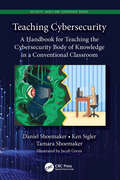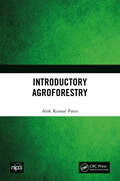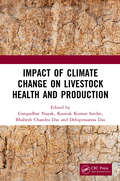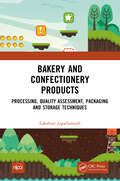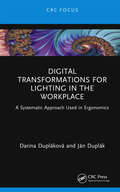- Table View
- List View
Handbook of Nanoencapsulation: Preparation, Characterization, Delivery, and Safety of Nutraceutical Nanocomposites
by Jasmeet KourNutraceutical encapsulation envelopes protection of products from oxidative damage, controlled delivery of nanoencapsulated nutraceuticals and improved nutraceutical bioavailability as well as biological action. It is a promising technique to ensure the stabilization of such labile compounds and to protect the core ingredients from premature reactions and interactions In a comprehensive manner, the Handbook of Nanoencapsulation: Preparation, Characterization, Delivery and Safety of Nutraceutical Nanocomposites presents various nanosystems/nanocarriers, physical and chemical techniques used in encapsulation of various nutraceuticals, and the targeted delivery of various significant nutraceuticals. This book bridges the gap between academia and research as it encompasses the ubiquitous applications of nanoencapsulation technique used on significant nutraceuticals derived from plants, animals as well as microalgae. Key Features: Provides a quick and easy access to major plant, animal and microalgae derived nutraceutical ingredients Discusses nanoencapsulation techniques for protection and targeted release of various food bioactive ingredients. Covers safety, bioaccessibility and multiple applications of nanoencapsulated nutraceuticals in the food industry Unveiling pivotal aspects of nanoencapsulation of significant nutraceuticals, this book is a valuable resource for researchers, food toxicologists, food scientists, nutritionists, and scientists in medicinal research.
Hydrometallurgical Recycling of Lithium-Ion Battery Materials (Electrochemical Energy Storage and Conversion)
by Joey Jung Pang-Chieh Sui Jiujun ZhangThe expanding market share of lithium-ion batteries (LIBs), driven by the secondary battery and electric vehicle markets, has consequently led to the accumulation of spent LIBs. This presents a unique business opportunity for recovering and recycling valuable metals from the spent lithium-ion cathode materials. Hydrometallurgical Recycling of Lithium-Ion Battery Materials provides a comprehensive review of the available hydrometallurgical technologies for recycling spent lithium-ion cathode active materials. The aim of this book is to raise awareness of LIB recycling, provide comprehensive knowledge of hydrometallurgical recycling of lithium cathode active materials, and promote an environmentally friendlier hydrometallurgical recycling process. Key Features • Summarizes current recycling processes, challenges, and perspectives • Offers a comprehensive review of current commercialized LIB recycling companies • Showcases an innovative closed-loop hydrometallurgical recycling process to recycle lithium cathode materials • Provides detailed modeling and economic analyses of several hydrometallurgical recycling processes • Features practical cases and data developed by the authors Offering the most up-to-date information on LIB material recycling, this book is aimed at researchers and professionals in materials, chemical, electrical, and mechanical engineering, as well as chemists working on battery technologies.
Handbook of Nanoencapsulation: Preparation, Characterization, Delivery, and Safety of Nutraceutical Nanocomposites
by Jasmeet Kour Raees Ul Haq Sajad Ahmad Wani Bhaskar JyotiNutraceutical encapsulation envelopes protection of products from oxidative damage, controlled delivery of nanoencapsulated nutraceuticals and improved nutraceutical bioavailability as well as biological action. It is a promising technique to ensure the stabilization of such labile compounds and to protect the core ingredients from premature reactions and interactions In a comprehensive manner, the Handbook of Nanoencapsulation: Preparation, Characterization, Delivery and Safety of Nutraceutical Nanocomposites presents various nanosystems/nanocarriers, physical and chemical techniques used in encapsulation of various nutraceuticals, and the targeted delivery of various significant nutraceuticals. This book bridges the gap between academia and research as it encompasses the ubiquitous applications of nanoencapsulation technique used on significant nutraceuticals derived from plants, animals as well as microalgae. Key Features: Provides a quick and easy access to major plant, animal and microalgae derived nutraceutical ingredients Discusses nanoencapsulation techniques for protection and targeted release of various food bioactive ingredients. Covers safety, bioaccessibility and multiple applications of nanoencapsulated nutraceuticals in the food industry Unveiling pivotal aspects of nanoencapsulation of significant nutraceuticals, this book is a valuable resource for researchers, food toxicologists, food scientists, nutritionists, and scientists in medicinal research.
Hydrometallurgical Recycling of Lithium-Ion Battery Materials (Electrochemical Energy Storage and Conversion)
by Joey Jung Pang-Chieh Sui Jiujun ZhangThe expanding market share of lithium-ion batteries (LIBs), driven by the secondary battery and electric vehicle markets, has consequently led to the accumulation of spent LIBs. This presents a unique business opportunity for recovering and recycling valuable metals from the spent lithium-ion cathode materials. Hydrometallurgical Recycling of Lithium-Ion Battery Materials provides a comprehensive review of the available hydrometallurgical technologies for recycling spent lithium-ion cathode active materials. The aim of this book is to raise awareness of LIB recycling, provide comprehensive knowledge of hydrometallurgical recycling of lithium cathode active materials, and promote an environmentally friendlier hydrometallurgical recycling process. Key Features • Summarizes current recycling processes, challenges, and perspectives • Offers a comprehensive review of current commercialized LIB recycling companies • Showcases an innovative closed-loop hydrometallurgical recycling process to recycle lithium cathode materials • Provides detailed modeling and economic analyses of several hydrometallurgical recycling processes • Features practical cases and data developed by the authors Offering the most up-to-date information on LIB material recycling, this book is aimed at researchers and professionals in materials, chemical, electrical, and mechanical engineering, as well as chemists working on battery technologies.
Mathematical Methods in Dynamical Systems
by S. Chakraverty Subrat Kumar JenaThe art of applying mathematics to real-world dynamical problems such as structural dynamics, fluid dynamics, wave dynamics, robot dynamics, etc. can be extremely challenging. Various aspects of mathematical modelling that may include deterministic or uncertain (fuzzy, interval, or stochastic) scenarios, along with integer or fractional order, are vital to understanding these dynamical systems. Mathematical Methods in Dynamical Systems offers problem-solving techniques and includes different analytical, semi-analytical, numerical, and machine intelligence methods for finding exact and/or approximate solutions of governing equations arising in dynamical systems. It provides a singular source of computationally efficient methods to investigate these systems and includes coverage of various industrial applications in a simple yet comprehensive way.
Mathematical Methods in Dynamical Systems
by S. Chakraverty Subrat Kumar JenaThe art of applying mathematics to real-world dynamical problems such as structural dynamics, fluid dynamics, wave dynamics, robot dynamics, etc. can be extremely challenging. Various aspects of mathematical modelling that may include deterministic or uncertain (fuzzy, interval, or stochastic) scenarios, along with integer or fractional order, are vital to understanding these dynamical systems. Mathematical Methods in Dynamical Systems offers problem-solving techniques and includes different analytical, semi-analytical, numerical, and machine intelligence methods for finding exact and/or approximate solutions of governing equations arising in dynamical systems. It provides a singular source of computationally efficient methods to investigate these systems and includes coverage of various industrial applications in a simple yet comprehensive way.
India's Approach to Border Management: From Barriers to Bridges
by Pushpita DasThis book attempts to provide a comprehensive understanding of the circumstances which have shaped India’s approach towards its international borders and the framework it has developed to better manage its borders. The book argues that persistence of various cross-border threats and challenges and an absence of robust intra-regional trade among its neighbouring countries forced India to employ a security-centric and unilateral approach to border management with emphasis on hardening the borders to cross-border trade and travel and keeping the border areas underdeveloped to act as a buffer against external conventional threats. Besides discussing the threats and challenges that India faces along the borders, the book aims to develop an understanding of India’s border management practices by analysing various programmes and initiatives such as the raising of border guarding forces; building of physical and electronic fences; the establishment of modern facilities for smoothening legitimate cross-border travel; the development of the border areas through special programmes; and increasing trade and connectivity as well as other cooperative bilateral mechanisms. Print edition not for sale in South Asia (India, Sri Lanka, Nepal, Bangladesh, Pakistan and Bhutan).
India's Approach to Border Management: From Barriers to Bridges
by Pushpita DasThis book attempts to provide a comprehensive understanding of the circumstances which have shaped India’s approach towards its international borders and the framework it has developed to better manage its borders. The book argues that persistence of various cross-border threats and challenges and an absence of robust intra-regional trade among its neighbouring countries forced India to employ a security-centric and unilateral approach to border management with emphasis on hardening the borders to cross-border trade and travel and keeping the border areas underdeveloped to act as a buffer against external conventional threats. Besides discussing the threats and challenges that India faces along the borders, the book aims to develop an understanding of India’s border management practices by analysing various programmes and initiatives such as the raising of border guarding forces; building of physical and electronic fences; the establishment of modern facilities for smoothening legitimate cross-border travel; the development of the border areas through special programmes; and increasing trade and connectivity as well as other cooperative bilateral mechanisms. Print edition not for sale in South Asia (India, Sri Lanka, Nepal, Bangladesh, Pakistan and Bhutan).
Teaching Cybersecurity: A Handbook for Teaching the Cybersecurity Body of Knowledge in a Conventional Classroom (Security, Audit and Leadership Series)
by Daniel Shoemaker Ken Sigler Tamara ShoemakerLet’s be realistic here. Ordinary K-12 educators don’t know what "cybersecurity" is and could probably care less about incorporating it into their lesson plans. Yet, teaching cybersecurity is a critical national priority. So, this book aims to cut through the usual roadblocks of confusing technical jargon and industry stovepipes and give you, the classroom teacher, a unified understanding of what must be taught. That advice is based on a single authoritative definition of the field. In 2017, the three societies that write the standards for computing, software engineering, and information systems came together to define a single model of the field of cybersecurity. It is based on eight building blocks. That definition is presented here. However, we also understand that secondary school teachers are not experts in arcane subjects like software, component, human, or societal security. Therefore, this book explains cybersecurity through a simple story rather than diving into execution details. Tom, a high school teacher, and Lucy, a middle school teacher, are tasked by their district to develop a cybersecurity course for students in their respective schools. They are aided in this by "the Doc," an odd fellow but an expert in the field. Together they work their way through the content of each topic area, helping each other to understand what the student at each level in the educational process has to learn. The explanations are simple, easy to understand, and geared toward the teaching aspect rather than the actual performance of cybersecurity work. Each chapter is a self-contained explanation of the cybersecurity content in that area geared to teaching both middle and high school audiences. The eight component areas are standalone in that they can be taught separately. But the real value lies in the comprehensive but easy-to-understand picture that the reader will get of a complicated field.
Teaching Cybersecurity: A Handbook for Teaching the Cybersecurity Body of Knowledge in a Conventional Classroom (Security, Audit and Leadership Series)
by Daniel Shoemaker Ken Sigler Tamara ShoemakerLet’s be realistic here. Ordinary K-12 educators don’t know what "cybersecurity" is and could probably care less about incorporating it into their lesson plans. Yet, teaching cybersecurity is a critical national priority. So, this book aims to cut through the usual roadblocks of confusing technical jargon and industry stovepipes and give you, the classroom teacher, a unified understanding of what must be taught. That advice is based on a single authoritative definition of the field. In 2017, the three societies that write the standards for computing, software engineering, and information systems came together to define a single model of the field of cybersecurity. It is based on eight building blocks. That definition is presented here. However, we also understand that secondary school teachers are not experts in arcane subjects like software, component, human, or societal security. Therefore, this book explains cybersecurity through a simple story rather than diving into execution details. Tom, a high school teacher, and Lucy, a middle school teacher, are tasked by their district to develop a cybersecurity course for students in their respective schools. They are aided in this by "the Doc," an odd fellow but an expert in the field. Together they work their way through the content of each topic area, helping each other to understand what the student at each level in the educational process has to learn. The explanations are simple, easy to understand, and geared toward the teaching aspect rather than the actual performance of cybersecurity work. Each chapter is a self-contained explanation of the cybersecurity content in that area geared to teaching both middle and high school audiences. The eight component areas are standalone in that they can be taught separately. But the real value lies in the comprehensive but easy-to-understand picture that the reader will get of a complicated field.
Soil Fertility and Nutrient Management: Principles and Practices
by SharanappaUnderstanding of the dynamics of plant nutrients in the soil provides scientific basis for efficient nutrient management. Soil organic matter not only provides the nutrients required by the crop but also improve the biological and physical properties of the soil. This book collects and discusses information on production and management of organic manures, biofertilizers, integrated nutrient management in cropping systems and nutrient management in problematic soils. Print and electronic editions not for sale in South Asia (India, Sri Lanka, Nepal, Bangladesh, Pakistan, Afghanistan and Bhutan).
Soil Fertility and Nutrient Management: Principles and Practices
by SharanappaUnderstanding of the dynamics of plant nutrients in the soil provides scientific basis for efficient nutrient management. Soil organic matter not only provides the nutrients required by the crop but also improve the biological and physical properties of the soil. This book collects and discusses information on production and management of organic manures, biofertilizers, integrated nutrient management in cropping systems and nutrient management in problematic soils. Print and electronic editions not for sale in South Asia (India, Sri Lanka, Nepal, Bangladesh, Pakistan, Afghanistan and Bhutan).
Rainfed Agriculture
by R.K. Nanwal G.A. RajannaThis book discusses various issues related to Rainfed Agriculture, for example: Soil and water conservation. Drought management strategies. Rain-water harvesting. Crops and cropping system for dryland agriculture. Conservation agriculture. Climate-smart agriculture and watershed management. The subject matter is both narrative and critical, explained with illustrations and tables. Print and electronic editions not for sale in South Asia (India, Sri Lanka, Nepal, Bangladesh, Pakistan, Afghanistan and Bhutan).
Internet of Things (IoT) Enabled Automation in Agriculture
by Rajesh Singh Anita Gehlot Bhupendra Singh Sushabhan ChoudhuryThis book provides basic knowledge of the programming and interfacing of devices with IoT modem and programming. The aim is to explain the basic steps to understand the IoT and its application in agriculture field. It will serve be a reference book for postgraduate and undergraduate Engineering students. Students from Electronics, Electrical, Mechatronics, Robotics, Mechanical, Computer science can use the book for their projects and research. This book is based entirely on the practical experience of the authors while undergoing projects with the students and industries. Print and electronic editions not for sale in South Asia (India, Sri Lanka, Nepal, Bangladesh, Pakistan, Afghanistan and Bhutan).
Introductory Agroforestry
by Alok Kumar PatraThe origin of agroforestry practices—growing trees and shrubs with food and fruit crops and grasses is traditional and very old—but the science of agroforestry is new. Years of experience and experiments have shown that agroforestry as a land-use system is capable of yielding both food and wood and at the same time helps in conserving and rehabilitating the ecosystems. It has the capability to increase the overall productivity of land, maintain the nutrient balance in the soil, and above all, protect the nature. In the recent years, agroforestry has been recommended as a core subject in the curriculum of B. Sc. (Forestry) and B. Sc. (Agriculture) courses of agricultural universities. This book has been divided into ten chapters covering very comprehensive information on all aspects of agroforestry including history, concepts, systems classification, tree-crop interactions, planning and management, diagnosis and design, policy and projects, and propagation and management practices of multipurpose trees. Print and electronic editions not for sale in South Asia (India, Sri Lanka, Nepal, Bangladesh, Pakistan, Afghanistan and Bhutan).
Rainfed Agriculture
by R.K. Nanwal G.A. RajannaThis book discusses various issues related to Rainfed Agriculture, for example: Soil and water conservation. Drought management strategies. Rain-water harvesting. Crops and cropping system for dryland agriculture. Conservation agriculture. Climate-smart agriculture and watershed management. The subject matter is both narrative and critical, explained with illustrations and tables. Print and electronic editions not for sale in South Asia (India, Sri Lanka, Nepal, Bangladesh, Pakistan, Afghanistan and Bhutan).
Internet of Things (IoT) Enabled Automation in Agriculture
by Rajesh Singh Anita Gehlot Bhupendra Singh Sushabhan ChoudhuryThis book provides basic knowledge of the programming and interfacing of devices with IoT modem and programming. The aim is to explain the basic steps to understand the IoT and its application in agriculture field. It will serve be a reference book for postgraduate and undergraduate Engineering students. Students from Electronics, Electrical, Mechatronics, Robotics, Mechanical, Computer science can use the book for their projects and research. This book is based entirely on the practical experience of the authors while undergoing projects with the students and industries. Print and electronic editions not for sale in South Asia (India, Sri Lanka, Nepal, Bangladesh, Pakistan, Afghanistan and Bhutan).
Introductory Agroforestry
by Alok Kumar PatraThe origin of agroforestry practices—growing trees and shrubs with food and fruit crops and grasses is traditional and very old—but the science of agroforestry is new. Years of experience and experiments have shown that agroforestry as a land-use system is capable of yielding both food and wood and at the same time helps in conserving and rehabilitating the ecosystems. It has the capability to increase the overall productivity of land, maintain the nutrient balance in the soil, and above all, protect the nature. In the recent years, agroforestry has been recommended as a core subject in the curriculum of B. Sc. (Forestry) and B. Sc. (Agriculture) courses of agricultural universities. This book has been divided into ten chapters covering very comprehensive information on all aspects of agroforestry including history, concepts, systems classification, tree-crop interactions, planning and management, diagnosis and design, policy and projects, and propagation and management practices of multipurpose trees. Print and electronic editions not for sale in South Asia (India, Sri Lanka, Nepal, Bangladesh, Pakistan, Afghanistan and Bhutan).
Impact of Climate Change on Livestock Health and Production
by G D Nayak K K Sardar B C Das D P DasThis volume of 30 chapters contributed by reputed authors covers: Diversification of livestock and crops. Integration of livestock systems with forestry and crop production. Drought and heat wave tolerant varieties. Strategies for reduction of Green House Gases emission from ruminants. Application of GIS and remote sensing technologies. Breeds with inherent genetic capabilities to adapt to climate change. This book also takes into account the climate change adaptation, mitigation practices, and policy frameworks for promotion of sustainable livestock and poultry production. Print and electronic editions not for sale in South Asia (India, Sri Lanka, Nepal, Bangladesh, Pakistan, Afghanistan and Bhutan)
Impact of Climate Change on Livestock Health and Production
by Gangadhar Nayak Kautuk Kumar Sardar Bhabesh Chandra Das Debiprasanna DasThis volume of 30 chapters contributed by reputed authors covers: Diversification of livestock and crops. Integration of livestock systems with forestry and crop production. Drought and heat wave tolerant varieties. Strategies for reduction of Green House Gases emission from ruminants. Application of GIS and remote sensing technologies. Breeds with inherent genetic capabilities to adapt to climate change. This book also takes into account the climate change adaptation, mitigation practices, and policy frameworks for promotion of sustainable livestock and poultry production. Print and electronic editions not for sale in South Asia (India, Sri Lanka, Nepal, Bangladesh, Pakistan, Afghanistan and Bhutan)
Conservation Agriculture and Climate Change: Impacts and Adaptations
by Rites H. Saha Dhananjay Barman Madhusudan Behera Gouranga KarConventional tillage and burning crop residues has degraded the soil resource base and intensified soil degradation with concomitant decrease in crop production capacity. The emerging issue of global warming coupled with greenhouse gases emissions has further aggravated the scenario. Conservation agriculture helps in reducing many negative effects of conventional agriculture such as soil erosion, soil organic matter decline, water loss, soil physical degradation, and fuel use. Conservation Agriculture helps improve biodiversity in the natural and agro-ecosystems. Complemented by other good agricultural practices including the use of quality seeds, integrated pest, nutrient and water management, Conservation Agriculture provides a base for sustainable intensification of the agricultural production system. Moreover, the yield levels in Conservation Agriculture systems are higher than traditional intensive tillage systems with substantially less production costs. This book provides comprehensive understanding of the subject with topics related to climate change mitigation strategies, approaches and impact of conservation agriculture on natural resource management. Print and electronic editions not for sale in South Asia (India, Sri Lanka, Nepal, Bangladesh, Pakistan, Afghanistan and Bhutan)
Bakery and Confectionery Products: Processing, Quality Assessment, Packaging and Storage Techniques
by Lakshmi JagarlamudiThis book is a comprehensive and practical day-to-day reference for undergraduate and postgraduate students in the discipline of Food Science and Technology. Different topics are discussed to provide a comprehensive knowledge of the theoretical as well as the applied aspects involved in processing of bakery and confectionery products to gain confidence in any dedicated reader to go for a startup in the field. It also covers information on ingredients to bakery and confectionery products, formulae and processes for bakers, equipment for bakers and confectionery units along with quality assessment and standards. It will also help those connected with industries – who supply ingredients, equipment and packaging materials for bakery and confectionery units. The book is also useful for students appearing in any competitive examination in the disciplines of Food Science, Food Science, Nutrition, and Food Technology. This title is co-published with NIPA. Taylor and Francis does not sell or distribute its print and electronic editions in India, Pakistan, Nepal, Bhutan, Bangladesh and Sri Lanka.
Conservation Agriculture and Climate Change: Impacts and Adaptations
by Ritesh Saha Dhananjay Barman Madhusudan Behera Gouranga KarConventional tillage and burning crop residues has degraded the soil resource base and intensified soil degradation with concomitant decrease in crop production capacity. The emerging issue of global warming coupled with greenhouse gases emissions has further aggravated the scenario. Conservation agriculture helps in reducing many negative effects of conventional agriculture such as soil erosion, soil organic matter decline, water loss, soil physical degradation, and fuel use. Conservation Agriculture helps improve biodiversity in the natural and agro-ecosystems. Complemented by other good agricultural practices including the use of quality seeds, integrated pest, nutrient and water management, Conservation Agriculture provides a base for sustainable intensification of the agricultural production system. Moreover, the yield levels in Conservation Agriculture systems are higher than traditional intensive tillage systems with substantially less production costs. This book provides comprehensive understanding of the subject with topics related to climate change mitigation strategies, approaches and impact of conservation agriculture on natural resource management. Print and electronic editions not for sale in South Asia (India, Sri Lanka, Nepal, Bangladesh, Pakistan, Afghanistan and Bhutan)
Bakery and Confectionery Products: Processing, Quality Assessment, Packaging and Storage Techniques
by Lakshmi JagarlamudiThis book is a comprehensive and practical day-to-day reference for undergraduate and postgraduate students in the discipline of Food Science and Technology. Different topics are discussed to provide a comprehensive knowledge of the theoretical as well as the applied aspects involved in processing of bakery and confectionery products to gain confidence in any dedicated reader to go for a startup in the field. It also covers information on ingredients to bakery and confectionery products, formulae and processes for bakers, equipment for bakers and confectionery units along with quality assessment and standards. It will also help those connected with industries – who supply ingredients, equipment and packaging materials for bakery and confectionery units. The book is also useful for students appearing in any competitive examination in the disciplines of Food Science, Food Science, Nutrition, and Food Technology. This title is co-published with NIPA. Taylor and Francis does not sell or distribute its print and electronic editions in India, Pakistan, Nepal, Bhutan, Bangladesh and Sri Lanka.
Digital Transformations for Lighting in the Workplace: A Systematic Approach Used in Ergonomics
by Darina Dupláková Ján DuplákDigital Transformations for Lighting in the Workplace: A Systematic Approach Used in Ergonomics offers a practical concept for the implementation of digital transformation in ergonomics in work settings. It specifically focuses on providing information about illumination in production and non-production fields, and the described design solutions are applicable in practice. The concepts can be used in a typical manufacturing workplace or an academic setting. The methods in the book complement the modern trend to digitalise the workplace, making the research and practical outcomes of this book compatible with the concept of Industry 4.0 - Digital Manufacturing. This title offers a systematic approach to the field of digital transformation for ergonomics. It presents an opportunity for the reader to learn to create a digital model for lighting by analysing mathematical models for calculation through formulas and simulation algorithms. To put learning into context, this book provides two case studies from the production and non-production sectors, including an example of a classroom. The reader will then be able to utilise the methods to create their own digitized illumination system. This monograph is an ideal read for academics and researchers working at universities in the field of Ergonomics and professionals in industrial management including those in manufacturing plants, ergonomists, designers from the industry sector, or people who are interested in ergonomics, digitization, and simulation of a working environment.




